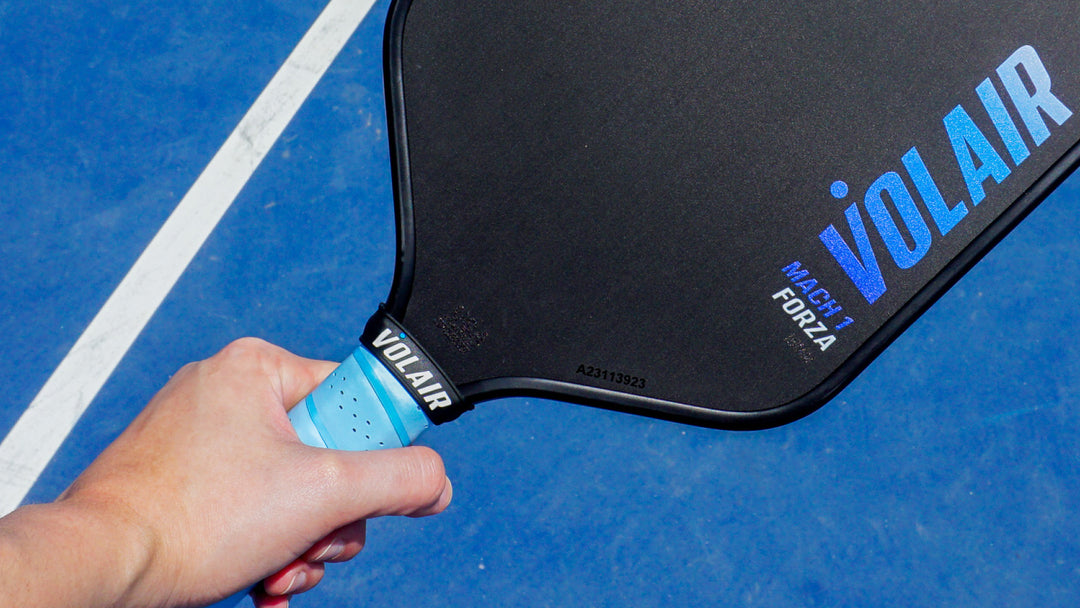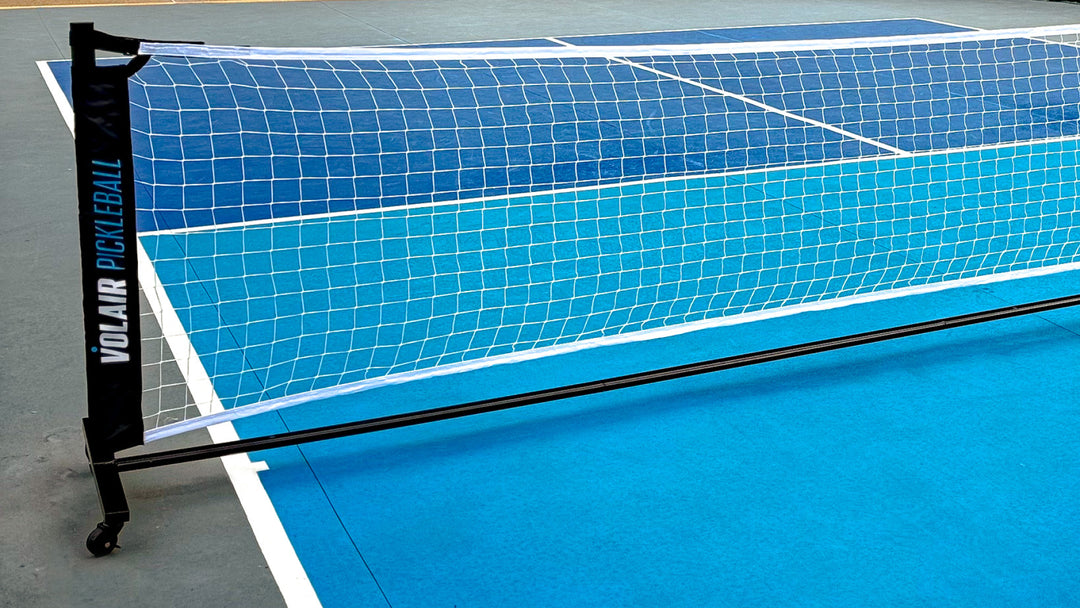Pickleball Footwork Fundamentals: How to Improve Your Pickleball Game
One of the biggest questions asked by amateur players in racket sports is ‘How do I improve my footwork’? This is one of the most important elements of pickleball but is often overlooked and almost never worked on. Good footwork maintains your balance throughout a point. Often players move more than necessary and are not only exhausted but also never fully recover from the previous shot. Thinking less is more is key to becoming more efficient on the court.
Whether you are a beginner-level player or a professional, footwork and balance are the most important fundamentals you need to know and execute well to become a top-level player. We will delve into the fundamental techniques, drills, and exercises to enhance your agility and overall performance on the pickleball court.
Why Excellent Footwork Matters- Stand Out From Your Competition
- Positioning: Correct footwork places you strategically, setting the stage for effective shots.
- Agility: Swift and efficient movement lets you cover the court effectively, reaching balls that might otherwise be out of reach.
- Stamina: Efficient movement conserves energy, enabling you to play limber and maintain peak performance throughout a match.
Common Footwork Mistakes - The Downfall of Too Many Players
- The lazy shuffle: Shuffling instead of taking proper steps to the ball.
- Overrunning on the court: Trying too hard, leading to being out of position and wasting valuable energy.
- Not split stepping: Remaining flat footed and neglecting the importance of split-stepping limits your ability.
The Crucial Ready Position in Pickleball - Your Foundation
Beginner-level players often hear about the importance of the ‘ready position’ . Establishing this early in your pickleball journey ingrains it into your game, paving the way for future success. The ready position begins with your feet shoulder-width apart, knees slightly bent, and weight on the balls of your feet. The paddle is extended out in front of your body at eye level. This stance allows for quick and balanced movement in any direction. A solid ready position should always be your starting point. It helps you see your paddle, react to the ball quicker, and hit the ball earlier. Many beginner level players ‘forget’ to reset into the ready position after every shot, leaving their paddle facing down or too close to their body. This inconsistency will cause you to lose focus and react a lot slower to the next incoming ball.
The ready position is displayed in action above by top Volair pro players. Notice the position of their paddles and their stance - Always ready and engaged for the next incoming shot.
Engage Your Brain, Engage Your Feet - Mastering the Split Step
Building on a solid ready position, the split step becomes the next challenge. The split step is a movement that started in tennis and several other racquet sports. This is a fundamental motion on the court and becomes so important the higher level you get. The similarities between tennis and pickleball made the split step an easy transition into the sport. This movement is a small bounce executed right before your opponent makes contact with the ball. The most effective split step is one that has a wide base and where your feet land in the direction of the court, landing on your toes rather than your heels. The split step gets you into an athletic-ready position where you’re engaging your legs. Just like any movement it does not have to be dramatic as the more subtle the split step is the quicker you will then be able to move and react to the ball. From this position, you can shift into many other shots, push off in different directions, or pivot your feet. You are a bigger threat in this position because you are ready to react and push off the ground compared to one where you’re already in motion.
In other words, it is better to hit the ball to a person in motion compared to a person who is in a ready position because the person in motion is shifting their weight and balance, their optimal strike zone is in motion, and they may have a harder time reacting to the shot. The goal is to always be mentally and physically engaged to receive the ball, the split step is just a repeatable mechanic for doing that.
Mastering the Shuffle Step at the Kitchen Line
Once you have mastered the split step, the next step is to focus on your movement at the kitchen line. When you’re at the non-volley zone, it’s important to continue to split step and keep your weight balanced as the ball is now coming towards you a lot quicker. You can move efficiently at the kitchen line using a shuffle step with your shoulders square to the net and always returning to a solid ready position and to the middle of your side of the court.
A Few Footwork Techniques You’ll Want to Avoid at the Kitchen Line
-
Lunging
- If you do this, you are not able to react quickly and the deeper you lunge the harder it is to step out of it.
-
Standing Up
- This is the equivalent of being off balance on the shot. You must be lower to the ground with your head still at contact. If you stand up, lift your head up or lean back it will most likely result in a missed shot or losing court position.
-
Putting Your Weight on Your Heels
- You don’t want to be caught flat-footed. If you need to cover a long distance quickly at the net, one useful technique is a cross step. If you’re not used to this, it can be a little harder to do especially if you’re hitting a backhand shot, so try ghosting this shot before trying it in a game.
Recovery and Court Positioning
Recovery and court positioning differs between singles and doubles but the common theme is not to leave large gaps or yourself or your partner exposed. When you’re playing doubles, you’ll want to follow the ball and move with your partner to ensure you are not leaving large gaps, specifically the middle of the court. One way to do this is to imagine there’s a rope tied between you and your partner. This will help you move together and cover the court quickly and efficiently. If one moves forward, the other should too. This ensures great court positioning as a team and avoids leaving space to exploit by your opponents. A standard and strong doubles position displayed by Volair pickleball pros below. Your goal as a team is to move up and stay up at the line as quickly and efficiently as possible.
Footwork isn't just about speed and agility, it's about being in the right position. Try to always come back to a centered position on the court. This minimizes the distance you need to move to reach the next shot. See Volair pros court positioning in the image below, showing both players in a wide centered position with eyes and body weight forward tracking the ball.

Stretching Your Boundaries - Paving a Healthy Pickleball Journey
In pickleball, there are certain motions and body mechanics that become habitual because of how the game is played. On one hand, you build muscle memory and you can do it without thinking, but on the other hand, your body can experience wear and tear over time which can lead to chronic pain or injuries. This is why it’s important to use good mechanics, to warm up, and to stretch before and after play.
In pickleball you are constantly advancing forward to the net. Although this is a simple motion, this motion over and over can cause wear and tear on your feet. Many players like to go straight in to match play with little to no warm up. With the body going in cold and not fully warmed up and stretched will lead to potential injury. This is why it’s important to stretch out your feet, your lower calves, and your upper body before and after play. The National Library of Medicine outlines the most common injuries in pickleball and how to prevent these from happening to you.
Finally, you must make sure you have a few good pairs of tennis shoes. Changing out your shoes every few months is crucial to avoid foot pain and to maximize the grip and comfort of the shoe. Regular running shoes won't cut it as they do not give you the level of ankle support, durability and comfort that a tennis shoe gives you on the court. Adding insoles to your shoes can also help in absorbing shock and avoiding regular foot or heel pain.
Why Practice Really Does Make Perfect
Now that you understand the most important footwork fundamentals, the next step is to practice, practice and pratice.. It's the same concept as trying to improve your dink shot or your backhand volley. If you do not drill consistently just playing matches will not improve that shot. Same with footwork.
And this is also why practicing pickleball drills is an effective way to improve your skills. Through repetition of correct form, what once was an activity that required concentration to complete can easily become like driving a car to work - you don’t even think about it. Below we dive into some fun exercises that will help improve your footwork and balance.
How to Improve Your Split Step - The X Drill
This is a great drill often used by tennis players but can be just as effective for the pickleball player. This drill is called the ‘X Drill’. You can do this on any indoor or outdoor court surface as long as you can draw out a large X letter that is shown in the below image. A player would start at the base of the X with their feet positioned in a wide starting position. The player would then do a small jump into the middle section of the X narrowing the feet before re-engaging to the top of the X. This would then be followed by the playing going backward into the middle of the X and then jumping back out to the start of the X. This would be continued for 30 to 60 seconds straight without stopping. If this drill is done consistently and correctly this will dramatically improve your balance, speed, and motion for the split step.
Check out this great video showcasing the split step in a pickleball match and some more great exercises to help improve this movement.
Master the Art of Fast Feet - Agility Ladders
Agility ladders can come in a lot of different sizes, long and short but are a great tool in improving your quick feet and balance on the court. You can set up a ladder inside or outside on a flat surface and from there, it is about practice and repetition. There are several variations you can do with an emphasis on speed, staying on your toes, and balance. This will also help improve your coordination and court awareness.

To challenge yourself further you can combine ladder drills, split stepping once you hit the end of the ladder and then hitting a shot in motion. This will not only work on your footwork but also shot preparation and technique in motion. This could be any shot like hitting a dink shot, drive or volley.
Making Bigger Steps to Success - Shadow Stroke Drill
A shadow drill, which is also referred to as shadow practice, consists of mimicking a shot before doing it with an actual pickleball. This helps players understand the body position and mechanics needed to execute the shot correctly without worrying about a paddle or ball.
More specifically, it's a valuable framework to improve form and footwork so you can go into a more simulated experience executing the fundamentals correctly. A shadow drill is one of the most effective ways to practice specific movements and footwork.
One of the biggest issues people have when they are moving on the court is picking up their feet and making too many steps to the ball. Too often you see a compressed posture which leads to bad court positioning and being off balance on the shot. A great drill to improve on this is the shadow stroke drill, which means you are going to mimic shots without actually hitting the ball. The goal is to get better at taking big dynamic steps to the ball and reaction time, all while creating forward momentum, pointing your toes toward a target, opening up your hips and being ready to take the shot if the ball comes your way.

Place markers on the court to start and shuffle sideways between them as fast as possible. Staying low to the ground, pushing off the outside leg and aiming to get to each cone with as little amount of steps as possible. This will help improve your lateral movement, helping you reach those tricky angled dink shots. After spending some time doing this drill and shadowing the stroke you can then progress this into a two player drill with your partner feeding you different shots and you then hitting the ball back to them or a target on the court.
Partner Drills - Reactivity and Coordination
When it comes to practicing it is more beneficial and a lot more fun to do so with a partner and there are many drills using just a pickleball. This drill will start with your partner throwing the ball underhand softly into different areas of the court with your goal being to catch the ball on the fly or off the bounce. This is not only a great warm-up drill but also works on reacting to the ball, positioning your body low and improving your hand-eye coordination. After a few successful minutes on this drill, you can then transition into hitting the ball rather than catching. Get your partner to hit shots in different areas of the court with your goal to hit it back to them or to a target.
The great part of any partner drill or footwork exercise is you can make it as easy or as challenging as you would like. Speeding it up, adding targets or focusing on hitting a certain part of the court can all significantly improve your movement, coordination, and shot execution.
Switch Sides Drill
If you're looking to improve your ability to hit shots from different positions on the court, the Switch Sides drill is perfect. This drill plays more like a small game, where players switch sides after every single shot, meaning if you hit from the right service area you'll shift to the left service area for your next shot, and continue this pattern throughout.
This drill will get you out of any flat feet issues you may be facing since you're constantly moving, and it will also challenge you to hit from different angles and distances.
- Play a game with your partner where you switch sides after every shot.
- Hit forehand and backhand groundstrokes from different positions on the court - no need to prescribe one style here.
- Focus on your footwork and positioning, and make sure you're hitting the ball with proper form - this means doing your best to keep the ball in front of you before you make contact and taking it from as high in the air as possible.
- Keep the game going for as long as you can, and try to hit as many winners as possible.
Evaluate Your Game and Execute
Applying the various drills and exercises outlined in this post are essential to improving your footwork and overall pickleball game. Identify your weaknesses and tailor your practice routine accordingly. Recognize the purpose of each drill and its impact on your game. Mastery of footwork is a gradual process; patience and persistence are key. As you improve and refine your footwork, you'll start to move more effortlessly around the court, surprising opponents with your agility and confidence.
Next time you make an error, analyze your feet and court position. The more you understand the role of footwork in your mistakes, the more consistent and aware you'll become as a competitive player. There's a high probability that your weakness can be improved with one of these drills highlighted. With enough practice you will reach your desired pickleball goals. If you hit any moments where you're questioning the purpose of drills and practice altogether, you must keep going as practice really does make progress.




